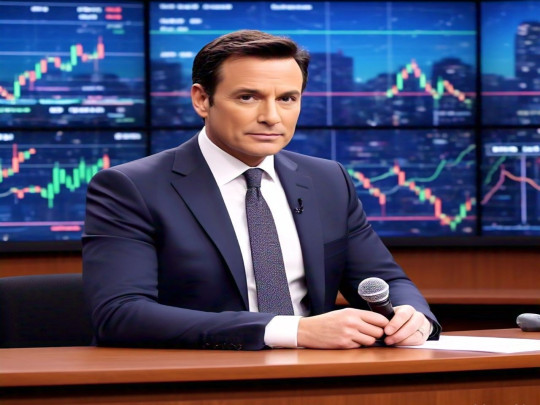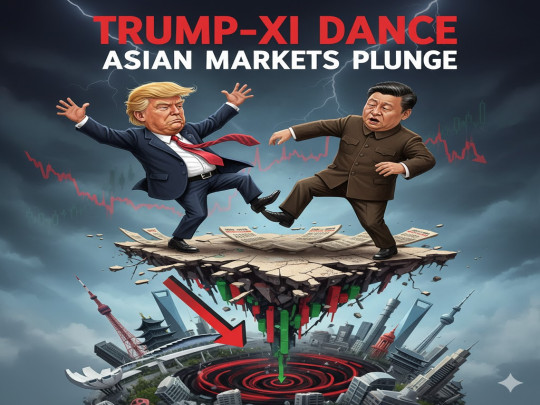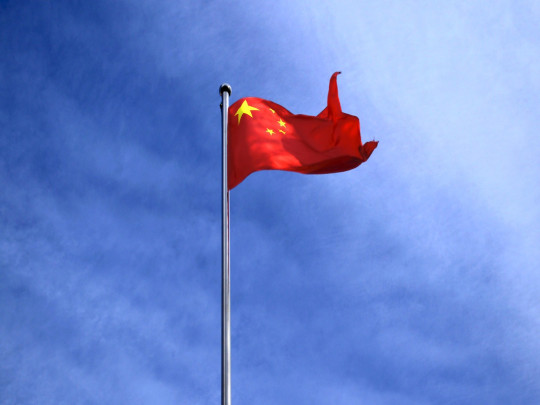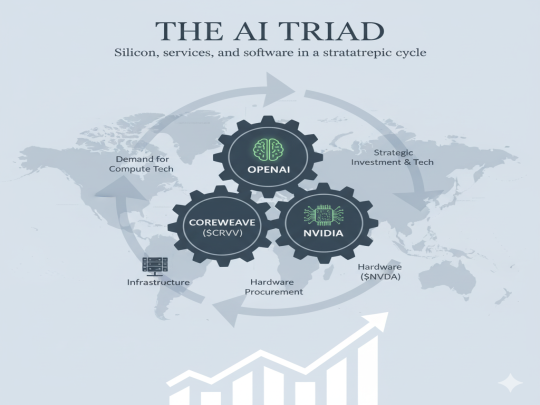Stock Market Update: Tesla Slides, Solar Stocks Sink, and Tariff Turmoil Weighs on Wall Street
Stock Market Update: Tesla tumbled after Elon Musk launched a new political party, while Sunrun, First Solar, and Enphase fell on rollback of green energy subsidies. JPMorgan, Goldman Sachs, and BofA dipped post-downgrades. Vertiv and Chemours gained.

- Early Tuesday US stock futures pointed to a modest rebound after President Trump signaled some flexibility on new tariffs, following a sharp market sell-off on Monday.
- Monday saw US stocks suffer their worst one-day drop since mid-June (Dow -0.94%) after President Trump announced steep new tariffs on 14 nations, renewing global trade fears.
- Monday's broad sell-off hit Japanese automakers and tech stocks. Tesla plunged nearly 7% after CEO Elon Musk announced he was starting a new political party.
- Notable premarket movers Tuesday included Solar stocks (Sunrun -7%) falling after Trump issued an executive order to roll back green energy subsidies. Datadog (-2%) was downgraded over risks related to its client OpenAI. Major banks also received downgrades from HSBC. Chemours (+10%) rallied strongly.
- The new tariffs, effective Aug 1, include rates of 25% on Japan, South Korea, and Malaysia, and up to 40% on other nations including Thailand and Laos. However, Trump later suggested the deadline was negotiable, sparking what some traders call the "TACO" (Trump Always Chickens Out) trade.
- The US dollar just completed its worst first half since 1973 (-10.7%). JPMorgan warned of stagflation risks from tariffs, though the latest AAII survey showed a surge in retail investor optimism.
- In company-specific news, IBM received a bullish analyst note, with Melius Research raising its price target to $350.
- Global markets Tuesday saw Europe open mixed. Asia was also mixed, with South Korea surging while the Reserve Bank of Australia surprised markets by holding rates.
- US Treasury yields had edged higher on Monday amid the tariff news, with the 10-year yield climbing 2 bps.
- Market sentiment was hit hard by the tariff announcement, but Trump's hint of flexibility led to some stabilization, with traders betting the harshest measures may be avoided.
Stocks tumbled on Monday as renewed trade tensions weighed heavily on investor sentiment. President Donald Trump announced steep new tariffs targeting imports from at least seven countries, igniting fears of another round of retaliatory measures and global trade disruptions. In a series of posts on Truth Social, Trump shared signed form letters addressed to leaders of South Korea, Japan, Malaysia, Kazakhstan, South Africa, Laos, and Myanmar, outlining new tariff rates that will take effect starting August 1.
The market reaction was swift and negative, with all three major U.S. stock indexes suffering their worst single-day losses since mid-June. The broad-based sell-off was fueled by concerns that escalating protectionist policies could derail the recent market rally and stall global economic growth.
However, late in the day, sentiment began to stabilize after Trump hinted at possible flexibility on the implementation of the tariffs. In a follow-up statement, the president clarified that the August 1 deadline was “not 100% firm” and that the U.S. would be open to alternative proposals from the affected countries. “If they call up and they say something a different way, we’re going to be open to that,” Trump said, signaling a potential willingness to negotiate.
Following those comments, stock futures pointed to a modest rebound, suggesting that markets were hoping for a less confrontational outcome in the days ahead. Still, the abrupt re-escalation of trade tensions injected fresh volatility into markets and underscored the fragility of investor confidence amid ongoing geopolitical uncertainty.
US Market Previous Day:
U.S. stocks suffered their steepest declines since mid-June on Monday, as investors reacted sharply to a fresh wave of trade policy announcements from President Donald Trump. The Dow Jones Industrial Average dropped 422.17 points, or 0.94%, to close at 44,406.36. The S&P 500 slid 0.79% to 6,229.98, while the Nasdaq Composite lost 0.92%, ending the session at 20,412.52. All three major indexes hit session lows in the afternoon, as selling pressure intensified.
The losses came after Trump revealed new steep tariff rates targeting imports from multiple countries, including key U.S. trading partners in Asia. Japanese automakers were particularly hard-hit, with shares of Toyota Motor down 4% and Honda Motor falling 3.9%. The auto sector faced investor concern over potential retaliatory actions and disruptions to supply chains.
Tech stocks also came under pressure. Tesla shares dropped nearly 7% after CEO Elon Musk said he was launching a new political party, a move that added to uncertainty surrounding the company’s leadership and strategic direction. Other big names in tech were also lower, with Apple and Alphabet down more than 1%, AMD losing over 2%, and Nvidia slipping slightly.
US Futures Remain Flat:
- Dow Jones Industrial Average futures remained flat with decline of 0.14%
- S&P 500 futures showed meagre gains of 0.04%
- Nasdaq Composite futures lead the pack with gains of 0.16%.
Biggest Premarket Movers
- Sunrun, First Solar, Enphase Energy: Solar stocks were under pressure on Tuesday morning. The declines followed President Donald Trump's issuance of an executive order that calls for rolling back green energy subsidies, aiming to “build upon and strengthen” some of the changes in the recent tax bill. Sunrun fell more than 7%, Enphase Energy dropped 3.7%, and First Solar slid 2.6%.
- Datadog: The cloud security stock fell more than 2% following a downgrade to "sell" from "neutral" at Guggenheim. The firm expressed concern that Datadog is at risk of losing significant revenue from its major client, OpenAI, should the artificial intelligence giant decide to build some of its required technology solutions in-house.
- JPMorgan Chase, Goldman Sachs, Bank of America: Shares of these three major banks were set to open lower after receiving downgrades from HSBC ahead of the second-quarter earnings season. JPMorgan and Goldman Sachs each dipped less than 1% after being downgraded to "reduce" from "hold," while Bank of America dropped 2% following a downgrade to "hold" from "buy."
- Shake Shack: Shares of the fast-casual restaurant slipped 1.4% after being downgraded to "hold" from "buy" at Loop Capital. The firm suggested that after a 60% surge over the last couple of months, the stock’s current valuation now accurately reflects Shake Shack’s fundamentals.
- Vertiv Holdings: The AI infrastructure stock rose 2.8% following an upgrade to "buy" from "hold" at Melius Research. The investment firm stated that “the race to spend on AI seems back on track,” a trend that would directly benefit Vertiv.
- KeyCorp: The financial stock rose about 1% in premarket trading after being upgraded to "buy" from "neutral" by UBS. The Wall Street firm highlighted KeyCorp's superior capital position, strong loan growth momentum, and the potential for positive surprises in its net interest income.
- Coinbase: The crypto exchange gained 1% after KULR Technology Group announced that it had secured a $20 million credit facility with Coinbase.
- Chemours: The chemicals company rallied more than 10%, putting it on track to extend its 11.7% gain from the past month. A specific catalyst for Tuesday’s significant move was not immediately clear.
Tariff Update:
In a series of posts to Truth Social on Monday, Trump released letters detailing new blanket tariff rates on 14 U.S. trading partners. Effective August 1, the U.S. will impose a 40% tariff on imports from Laos and Myanmar, 36% on Cambodia and Thailand, and 35% on Bangladesh and Serbia. Indonesia will face a 32% rate, while Bosnia and Herzegovina and South Africa will see 30%. Japan, Kazakhstan, Malaysia, South Korea and Tunisia are each set to face a 25% tariff.
These rates largely mirror the ones Trump proposed back in April as part of his “reciprocal tariffs” push, though that earlier round was paused before taking effect. On Monday, Trump signed an executive order extending the implementation date to August 1. White House Press Secretary Karoline Leavitt said that additional rate letters would be released in the coming days, with more trade-related announcements expected soon. Treasury Secretary Scott Bessent confirmed on CNBC that several new trade moves would be unveiled within 48 hours.
Despite the aggressive tone of the announcements, investor reaction was relatively calm compared to the heavy volatility seen in April. The difference this time appears to stem from Trump's increasingly flexible rhetoric. Speaking to reporters, the president said the August 1 deadline was “firm, but not 100% firm,” suggesting room for negotiations. That sentiment helped feed into what traders are dubbing the return of the “TACO” — Trump Always Chickens Out — trade, with markets betting that the harshest measures might ultimately be softened or delayed.
Earnings Season/Company News:
Tesla shares weighed heavily on the broader market Tuesday, sliding nearly 7% after CEO Elon Musk announced plans to launch a new political outfit called the “America Party.” The move adds to investor unease about Musk’s increasing political entanglements, which many believe have negatively affected Tesla’s public image and car sales throughout the year. With demand in key markets already under pressure, analysts are concerned that Musk’s divisive political positioning could further erode the brand’s consumer appeal.
Meanwhile, IBM shares continued their upward march, gaining further investor confidence following a bullish note from Melius Research. Analyst Ben Reitzes raised his price target on the stock to $350 from $287 — suggesting nearly 20% upside from recent levels — citing the company's transition toward infrastructure-focused software. According to Reitzes, IBM’s strategy to focus on more embedded, usage-based software is proving resilient, especially compared to more vulnerable seat-based SaaS models threatened by the rise of generative AI. He also projected IBM’s free cash flow would exceed its $13.5 billion target, growing 6% this year and at least 8% annually in 2026 and 2027.
Global Market Trends:
European shares were mixed on Tuesday as investors responded to President Donald Trump’s escalating trade rhetoric. The pan-European STOXX 600 dipped 0.1% to 542.73, with many traders cautious ahead of a possible trade agreement between the bloc and the U.S. by the original July 9 deadline. On the economic front, Germany’s exports fell more than expected in May, marking the second consecutive monthly decline in shipments to the U.S., following a surge earlier this year driven by pre-tariff stockpiling.
In the Asia-Pacific region, markets fluctuated as traders digested Trump’s renewed threats targeting 14 countries with new tariffs. Japan’s Nikkei 225 rose 0.26% to 39,688.81, while the broader Topix climbed 0.17%. South Korea led regional gains, with the Kospi surging 1.81% and the Kosdaq up 0.74%. China’s CSI 300 added 0.84%, and Hong Kong’s Hang Seng Index gained 1.09%. Australia’s ASX 200 was flat at 8,590.70, after the Reserve Bank of Australia surprised markets by keeping interest rates unchanged at 3.85%, citing concerns over slowing domestic consumption and external risks.
Debt Market:
In the U.S. bond market, Treasury yields nudged slightly higher as traders continued to evaluate the latest round of tariff developments. The 10-year yield climbed 2 basis points to 4.415%, while the 30-year yield also added 2 basis points to reach 4.952%. The 2-year note held steady at 3.907%, suggesting a modest steepening of the yield curve as longer-term inflation and growth expectations remain in focus.
Commodities and Other Assets:
The U.S. dollar just had its worst first half since 1973. Through June, the U.S. currency fell 10.7% against its global peers, and the road ahead doesn’t look any smoother. policy volatility, growing debt and deficits, and possible interest rate cuts will likely remain considerations for investors in the second half. Still, some on Wall Street believe the downward trend could reverse. Treasury Secretary Scott Bessent told CNBC on Monday that currency fluctuations are “not out of the ordinary.”
A potential stagflation scenario is still a risk to the “Goldilocks narrative” that has helped usher in new highs in the stock market, according to JPMorgan. JPMorgan strategist Mislav Matejka said in a note to clients Monday that negative impacts from tariffs should start to show up in the coming months, with economic growth potentially being cut by half.
Retail investors were the most bullish toward the six-month outlook for stocks late last week since December, 2024, according to the latest weekly poll from the American Association of Individual Investors. Optimism jumped to 45.0% from 35.1% the week before and was above the long-term historical average of 37.5% for the first time since May. Bearish opinion slumped to 33.1% of investors, down from 40.3% one week earlier, and only a little above the long-run historical average of 31.0%. Only 21.9% of investors said they were neutral about the short-term outlook for stocks, far below the historic average of 31.5%.
Market Sentiment:
The U.S. dollar just wrapped up its worst first-half performance since 1973, sliding 10.7% against a basket of global currencies through June. A range of factors have contributed to the greenback’s decline, including heightened policy uncertainty, the growing U.S. fiscal deficit, and expectations that the Federal Reserve could start cutting interest rates in the coming months. Treasury Secretary Scott Bessent attempted to calm concerns, telling CNBC on Monday that such currency swings are “not out of the ordinary,” but investors remain cautious heading into the second half of the year.
Amid broader market gains, JPMorgan is warning that risks of stagflation — stagnant growth combined with rising inflation — could derail the so-called “Goldilocks” narrative that has supported the recent rally in equities. Strategist Mislav Matejka noted that the economic effects of tariffs implemented in recent months may start to appear more clearly over the next quarter, potentially slashing GDP growth by half and challenging current market valuations.
Still, sentiment among retail investors remains upbeat. According to the latest weekly survey from the American Association of Individual Investors, optimism about the six-month outlook for stocks surged to 45.0% — the highest level since December 2024. Bearish sentiment fell to 33.1% from over 40% the previous week, while neutral sentiment dropped sharply to just 21.9%, well below its long-term average. This rising optimism among individual investors suggests growing confidence in the resilience of equity markets, even amid macroeconomic uncertainties.



